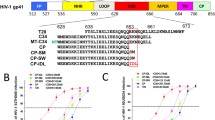Abstract
Two new proteins of approximately 70 amino acids in length, corresponding to an unnaturally-linked N- and C-helix of the ectodomain of the gp41 protein from the human immunodeficiency virus (HIV) type 1, were designed and characterized. A designed tripeptide links the C-terminus of the C-helix with the N-terminus of the N-helix in a circular permutation so that the C-helix precedes the N-helix in sequence. In addition to the artificial peptide linkage, the C-helix is truncated at its N-terminus to expose a region of the N-helix known as the “Trp-Trp-Ile” binding pocket. Sedimentation, crystallographic, and nuclear magnetic resonance studies confirmed that the protein had the desired trimeric structure with an unoccupied binding site. Spectroscopic and centrifugation studies demonstrated that the engineered protein had ligand binding characteristics similar to previously reported constructs. Unlike previous constructs which expose additional, shallow, non-conserved, and undesired binding pockets, only the single deep and conserved Trp-Trp-Ile pocket is exposed in the proteins of this study. This engineered version of gp41 protein will be potentially useful in research programs aimed at discovery of new drugs for therapy of HIV-infection in humans.









Similar content being viewed by others
References
Lu M, Blacklow SC, Kim PS (1995) Nat Struct Biol 2:1075
Moore JP, Doms RW (2003) Proc Natl Acad Sci 100:10598
Kilby JM (1999) Expert Opin Investig Drugs 8:1157
Chan DC et al (1998) Proc Natl Acad Sci 95:15613
Eckert DM et al (1999) Cell 99:103
Mo HM et al (2004) Virology 329:319
Zho G et al (2000) Bioorg Med Chem 8:2219
Liu S, Jiang S (2004) Curr Pharm Des 10:1827
Jin B-S et al (2005) J Biomol Screen 10:13
Frey G et al (2006) Proc Natl Acad Sci 103:13938
Cianci C et al (2004) Proc Natl Acad Sci 101:15046
Hajduk P et al (2000) J Am Chem Soc 122:7898
King DS, Fields CG, Fields GB (1990) Int J Pept Protein Res 36:255
Holzman T (1994) In: Schuster TM, Lave TM (eds) Modern analytical ultracentrifugation. Birkhauser, Boston, MA, p 298
Cohen EJ, Edsall JT (1943) Proteins, amino acids, and peptides as ions and dipolar ions. Rheinhold, New York, ch 4, p 157
Harlan JE et al (2003) Assay Drug Develop Technol 1:507
AMORE (Collaborative Computational Project, Number 4, 1994). Acta Crystallogr D50:760
Brunger AT (1992) Nature 355:472
Root MJ, Kay MS, Kim PS (2001) Science 291:884
Acknowledgment
This manuscript is dedicated to Yvonne Connolly Martin. The precepts of molecular properties and architectures promulgated by Yvonne in 41 years at Abbott extend even to the level of protein design. All of the authors thank her for being a steadfast source of inspiration and scientific role-model of the highest degree. Crystallographic data were collected at beamline 17-ID in the facilities of the Industrial Macromolecular Crystallography Association Collaborative Access Team (IMCA-CAT) at the Advanced Photon Source. These facilities are supported by the companies of the Industrial Macromolecular Crystallography Association.
Author information
Authors and Affiliations
Corresponding author
Rights and permissions
About this article
Cite this article
Stewart, K.D., Steffy, K., Harris, K. et al. Design and characterization of an engineered gp41 protein from human immunodeficiency virus-1 as a tool for drug discovery. J Comput Aided Mol Des 21, 121–130 (2007). https://doi.org/10.1007/s10822-007-9107-1
Received:
Accepted:
Published:
Issue Date:
DOI: https://doi.org/10.1007/s10822-007-9107-1




